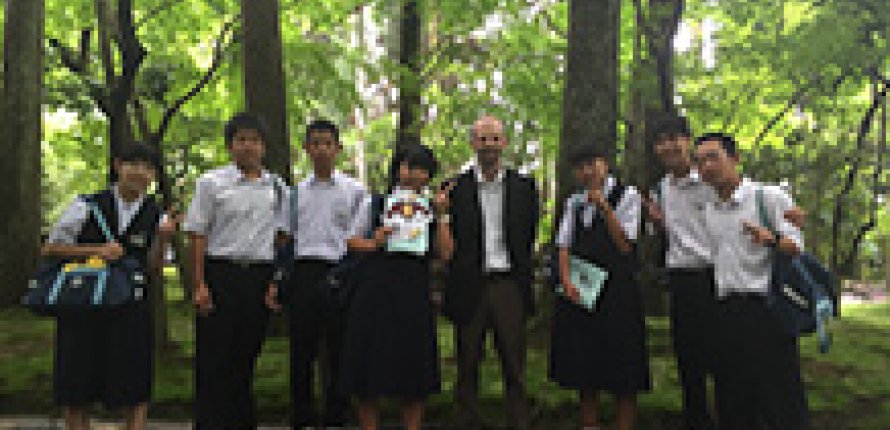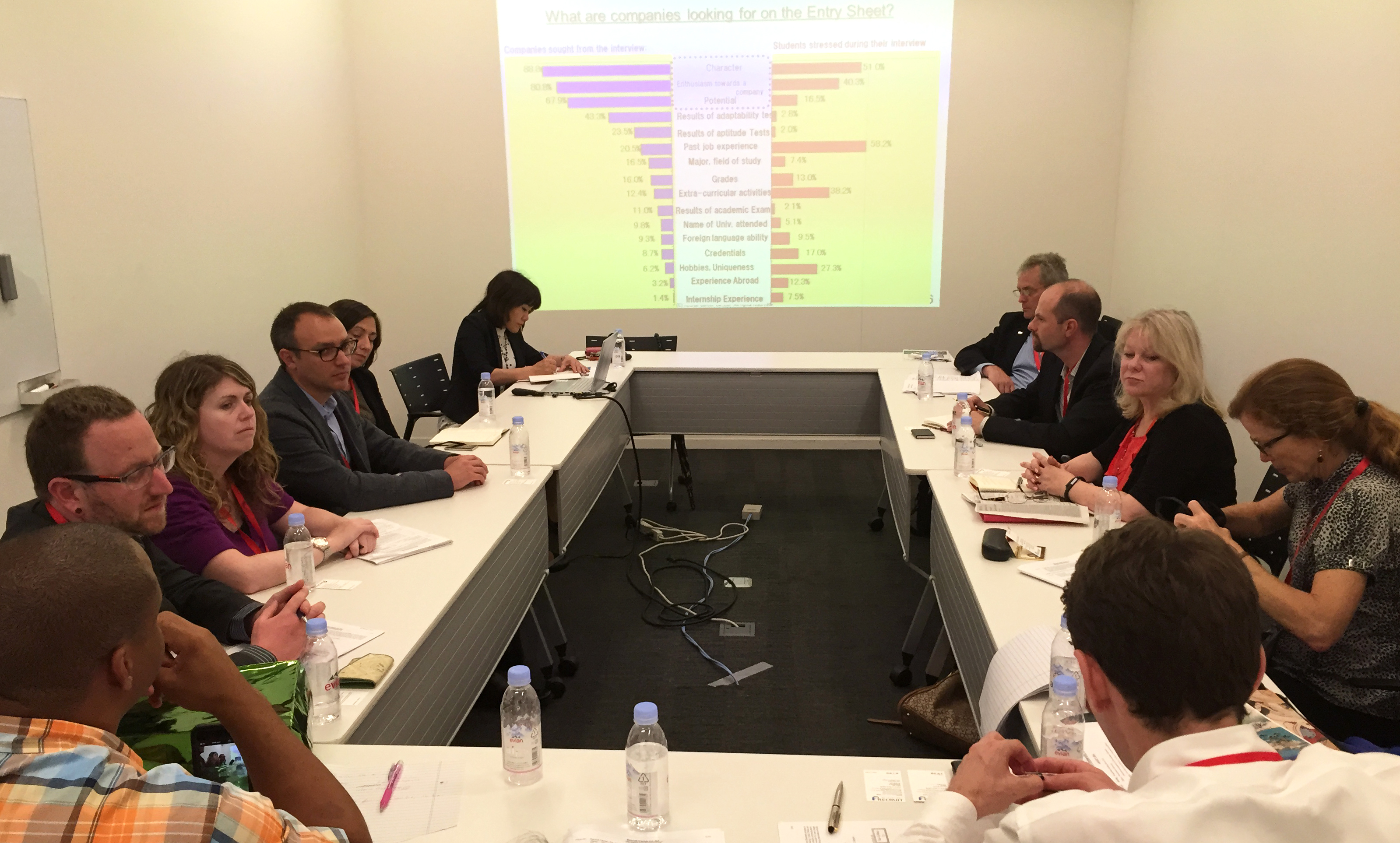Lessons Learned from an International Education Administrators Seminar to Japan

Aaron Basko, Assistant Vice President of Education, Salisbury University
2015 Fulbright International Education Administrators (IEA) Seminar Participant to Japan
Here I am, standing at ground zero of one of the most tragic losses of human life of the 20th century – Peace Park in Hiroshima, site of the first atomic bomb drop. Unlike the typical American visitor, my guides are young college students from Hiroshima Shudo University, including one student named Yuki, who is so knowledgeable that our Fulbright seminar group has nicknamed her “Yukipedia.” Yuki’s first stop on our tour at the Peace Park is to introduce us to her uncle (actually a close friend of her family), who is an in-utero survivor of the atomic blast. This gentleman of almost 70 has dedicated the later years of his life to telling the history of this spot and what it should teach about the future.
As a university administrator with a specialty in enrollment, career development, and retention, I never thought I would be eligible to receive a Fulbright grant. A year earlier, a colleague told me about the Fulbright International Administrator Seminar (IEA) program, which was designed to allow non-faculty whose work includes the promotion of international education on campus to participate in short-term grants. The seminars serve as an intensive course in comparative higher education in the host country, but they also act as a springboard for partnerships and projects that will increase student mobility between the host country and U.S. institutions.
At the time I applied, Fulbright offered IEA seminars in five countries, but there was no question I would apply for the Japan program. First, I had a personal interest. Over 20 years ago, as a freshman in college, I made friends with a Japanese student in my residence hall. He spent part of a summer at my home and shared a great deal about the Japanese culture with me and with my family. I told myself then if I ever had the opportunity to see Japan for myself, and perhaps to connect with my friend on his home turf, I would take it. I also had a professional interest. The university at which I work was exploring new partnership opportunities in Japan. In fact, we had just received our first group of newly enrolled Japanese students from a new partnership. As one of the primary players in our efforts to build up our international capacity, I knew I needed to better understand Japanese culture – both to support our incoming students and to facilitate new opportunities in the region.

I received notification of my grant in March, along with the biographies of nine other international education professionals with whom I would travel. We began communicating with each other almost immediately. We compared notes on Japan, arranged travel together, and each did our part to buy thank you gifts for the universities that would host us. In the meantime, I did my homework, meeting with as many of our Japanese students as I could, picking up a few useful phrases, and taking notes on the huge stack of articles that Fulbright provided in advance of our departure.
By the time of my visit to Hiroshima, I had already spent one week immersed in Japanese higher education. Our IEA group had been oriented by local experts and visited the Ministry of Education, Culture, Sports, Science and Technology (MEXT) to talk about the government’s massive funding plan to strengthen international education. We toured a wide range of universities to see how that plan was shaping up on the ground, and we (more or less) mastered the Tokyo subway system.
For the weekend in Hiroshima, we were hosted by Mr. Otsu, a faculty member at Hiroshima Shudo University. Although Mr. Otsu was approaching retirement, his memories of his own Fulbright experience many years ago, and his love for the program, remained strong. He spared no effort in welcoming us to Hiroshima, hosting a welcome reception sponsored by Fulbrighters from the region and introducing us to the fine art of Japanese karaoke. On Friday, he introduced us to English classes at Hiroshima Shudo for roundtable discussions and student presentations. On Saturday morning, those same terrific students arrived at our hotel to take us sightseeing. We spent the morning at the nearby holy island of Miyajima, an incredibly beautiful and inspiring cultural treasure. In the afternoon, we visited the Peace Park with its silent monuments and deeply moving museum remembering those who died in this place.
It is there that I learn my greatest lesson, not from Yuki’s uncle, but from the students themselves. After all, these are the grandchildren of people who died here, in a war in which we were the enemy. We had spent most of the day together, smiling, laughing, learning, and taking lots of pictures. But in this solemn place, we had to ask a hard question: How do they really feel about being here with us?
As we talked, it became obvious that the students really like the United States. All of them had either recently studied in the United States or were hoping to do so shortly and were working very hard on their English to help them get there. They felt this sense of connection that I didn’t understand, as if even the tragedy has given us a shared history. How was this possible?
I thought back to a lecture our group received in our day-one orientation describing post-war Japan. The Japanese university scholar presenting to us described the United States as having a choice to make about how it would approach occupation. In that historic moment it chose to invest heavily in rebuilding Japan – not just its infrastructure, but in the education and potential of its future leaders. In that moment, the Fulbright Program and its predecessor in Japan, the GARIOA program, became a symbol and a test case for whether an investment in education and understanding could shape the course of nations. Hundreds of bright, young Japanese students were given the opportunity to study in the United States and to begin building a new relationship between the two countries.
What was the result? When our group visited Japan’s Ministry of Education, we toured its small museum. At one point, we passed a wall covered with the pictures of Nobel Prize winners, eminent scientists, government leaders, and prominent citizens. Our guide from the Ministry paused for a moment, then began pointing rapidly, saying, “Fulbrighter, Fulbrighter, Fulbrighter, Fulbrighter…”
These were the people who shaped modern Japan. Their echo, and the echo of the investment in the program of which I was now a part, reverberates around me in the smiling faces of students two generations removed. I know my perspective on the power of education will never be the same.
Since returning from my IEA experience, I think of myself less as an enrollment and retention specialist and more as a capacity-builder. It is clear to me how much of our learning happens in these little moments of exchange like I experienced at the Peace Park. My effectiveness as an educator depends on my ability to expand the capacity of the students I work with to experience these exchange moments and learn from them. My impact as an administrator comes from the opportunity I have to build the capacity of the university I work for to deliver these kind of experiences. The Fulbright IEA program unlocked this door for me and has made me a much more effective champion for international education on my campus and in my community.
After the official end of the IEA seminar, on the morning I was scheduled to fly home, I ate breakfast on a little side street outside of Tokyo’s enormous fish market with my Japanese college friend from more than 20 years earlier. He brought along his five-year-old daughter who practiced her English with me. He suggested that when she is older perhaps he should send her over to visit our family. I thought about the Fulbright story that I have learned at Peace Park and I am reminded that even what may seem like a small stone thrown into the water can ripple for generations.
